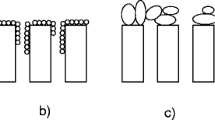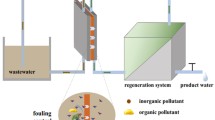Abstract
Fouling alleviation and control in full-scale reverse osmosis (RO) processes can be seriously hindered by ineffective fouling characterization. Fouling characterization is currently done primarily by measuring the silt density index (SDI) of feed water and monitoring the average permeate flux of full-scale RO processes. However, the SDI or related fouling indices have been known not capable to catch all possible foulants to RO membranes, and the average permeate flux may fail to correctly reflect membrane fouling in full-scale RO processes under certain circumstances.
In this chapter, an advanced characterization method is introduced for membrane fouling in full-scale RO processes. An inclusive fouling potential indicator is proposed for a better characterization of the fouling strength of feed water, which is defined in a way that it can be easily determined with a small lab-scale RO membrane device and that it is readily usable to predict fouling development in the full-scale RO processes. A model based on basic membrane filtration and mass conservation principles is presented to calculate the average permeate flux in a full-scale RO process as fouling is progressing. The main intention of the advanced characterization method is to provide a reliable assessment of membrane fouling in the full-scale RO processes, so that the need for pilot tests can be significantly reduced.
Access this chapter
Tax calculation will be finalised at checkout
Purchases are for personal use only
Similar content being viewed by others
References
Loeb S, Sourirajan S (1962) Sea water demineralisation by means of an osmotic membrane. Adv Chem Ser 38:117–132
Martin-Lagardette JL (2000) Competing seawater desalination technologies help to meet demand for fresh water. Memb Technol 124:11–12
Committee on Advancing Desalination Technology (NRC) (2008) Desalination: a national perspective. National Academies Press, Washington DC
Mallevialle J, Odendaal PE, Wiesner MR (1996) The emergence of membranes in water and wastewater treatment. In: Mallevialle J et al (eds) Water treatment membrane processes. McGraw Hill, New York
Shannon MA, Bohn PW, Elimelech M, Georgiadis JG, Marinas BJ, Mayes AM (2008) Science and technology for water purification in the coming decades. Nature 452:301–310
Pantell SE (1993) Seawater desalination in California. California Coastal Commission, California
Bryne W (1995) Reverse osmosis – a practical guide for industrial users. Tall Oaks, Littleton
Mulder M (1996) Basic principles of membrane technology, 2nd edn. Kluwer, London
AWWA Membrane Technology Research Committee (1992) Committee report: membrane processes in potable water treatment. J Am Water Works Assoc 84(1):59–64
Avlonitis SA, Kouroumbas K, Vlachakis N (2003) Energy consumption and membrane replacement cost for seawater RO desalination plants. Desalination 157:151–158
Dudley L, Vigo Pisano F, Fazel M (2000) Optimizing membrane performance – practical experiences. Membr Technol 121:5–8
Madaeni SS, Mohamamdi T, Moghadam MK (2001) Chemical cleaning of reverse osmosis membranes. Desalination 134:77–82
Shahalam AM, Al-Harthy A, Al-Zawhry A (2002) Feed water pretreatment in RO systems: unit processes in the Middle East. Desalination 150:235–245
Kaakinen JW, Moody CD (1985) Characteristics of reverse osmosis membrane fouling at the Yuma desalting test facility. In: Sourirajan S, Matsuura T (eds) Reverse osmosis and ultrafiltration. American Chemical Society, Washington DC
Song L, Chen KL, Ong SL, Ng WJ (2004) A new normalization method for determination of colloidal fouling. J Colloid Interface Sci 271:426–433
Singh G, Song L (2005) Quantifying the effect of ionic strength on colloidal fouling potential in membrane filtration. J Colloid Interface Sci 284(2):630–638
Singh G, Song L (2005) Influence of various monovalent cations and calcium ion on the colloidal fouling potential. J Colloid Interface Sci 289(2):479–487
Song L, Hong S, Hu JY, Ong SL, Ng WJ (2002) Simulations of full-scale reverse osmosis membrane process. J Environ Eng 128:960–966
Zhou W, Song L, Tay KG (2006) A numerical study on concentration polarization and system performance of spiral wound RO membrane modules. J Memb Sci 271:38–46
Tay KG, Song L, Ong SL, Ng WJ (2005) Nonlinear behavior of permeate flux in full-scale reverse osmosis processes. J Environ Eng 131:1481–1487
Chen KL, Song L, Ong SL, Ng WJ (2004) Prediction of membrane fouling in full-scale RO process. J Memb Sci 232:63–72
Rico PD, Arias MFC (2001) A reverse osmosis potable water plant at alicante university: first year of operation. Desalination 137:91–102
Saad MA (1999) Optimize water cost by early prediction of membrane system fouling trends. In: IDA World Congress on desalination and water reuse, San Diego, CA
Keith S (1995) Handbook of industrial membranes, 1st edn. Elsevier Advanced Technology, Oxford
Lennitech BV (2010) Membrane fouling. Delft, The Netherlands. http://www.lenntech.com/membrane-fouling.htm
Water Treatment Guide (2010) Solutions to membrane fouling. Technical Database for the Water Treatment Industry. http://www.watertreatmentguide.com/membrane_fouling_solutions.htm
Bartels C, Lai K, Wilf M (2007) New generation of low fouling nanofiltration membranes. EDS Conference, Halkidiki, Greece, April, 2007
Wiesner Research Group, Membranes Fouling (2010) Investigation of the nature of adhesion of organic foulants to membrane surfaces and strategies for cleaning. http://wiesner.cee.duke.edu/?q=node/70
Author information
Authors and Affiliations
Editor information
Editors and Affiliations
Rights and permissions
Copyright information
© 2011 Springer Science+Business Media, LLC
About this chapter
Cite this chapter
Song, L., Tay, K.G. (2011). Advanced Membrane Fouling Characterization in Full-Scale Reverse Osmosis Processes. In: Wang, L.K., Chen, J.P., Hung, YT., Shammas, N.K. (eds) Membrane and Desalination Technologies. Handbook of Environmental Engineering, vol 13. Humana Press, Totowa, NJ. https://doi.org/10.1007/978-1-59745-278-6_3
Download citation
DOI: https://doi.org/10.1007/978-1-59745-278-6_3
Published:
Publisher Name: Humana Press, Totowa, NJ
Print ISBN: 978-1-58829-940-6
Online ISBN: 978-1-59745-278-6
eBook Packages: EngineeringEngineering (R0)




